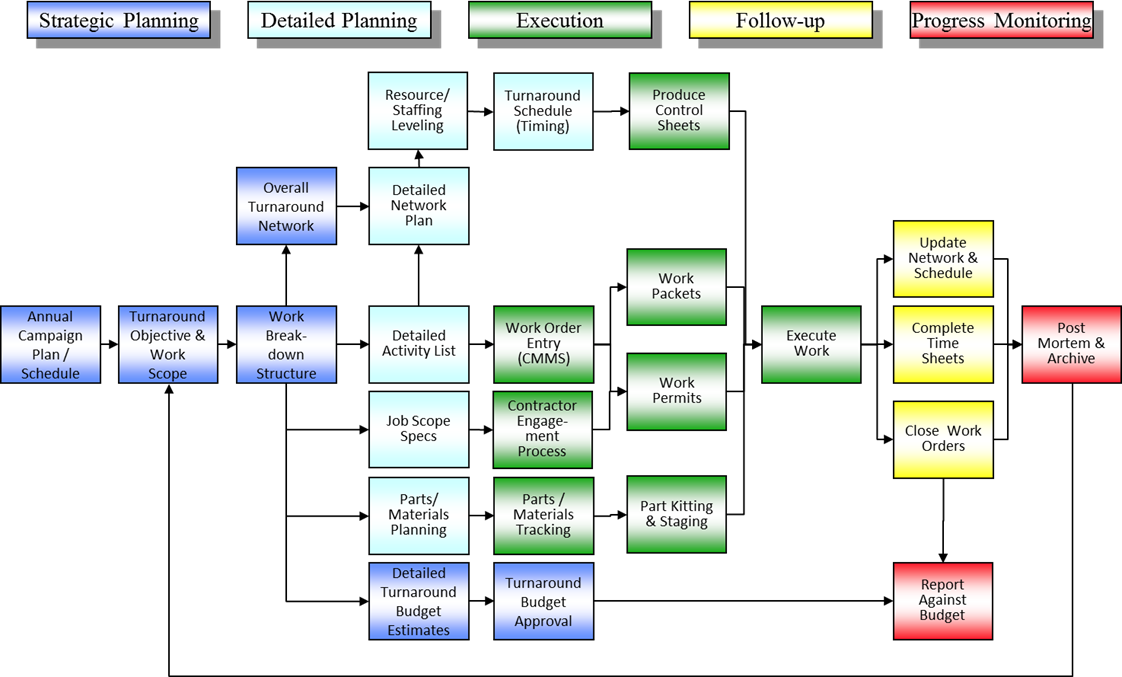
An Approach for Efficient Plant Turnarounds
Having excellent On-Stream Time is the bread and butter of any processing plant or other facility that produces chemicals, power, pulp, etc. Effective maintenance practices minimize downtime by focusing and coordinating preventive and corrective maintenance activities. There is however another entire category of downtime; that is the downtime driven by Turnarounds. Paul Harker, Senior Operations Manager with USCCG, explains the best approach to Turnarounds below.
The objective of a Turnaround (TA) is to complete all essential maintenance work required to ensure that the area runs reliably for an entire production campaign. This must be done while keeping the TA duration as short as possible to minimize the loss of production.
Turnarounds exist for two reasons:
- There are some maintenance activities that can only take place completely and safely when the plant is down.
- A correctly scoped Turnaround, executed in the minimum time required, prevents unplanned down events that ultimately cause greater total downtime.
Without a comprehensive approach to turnarounds, an organization exposes itself to a number of issues:
- There may be no annual Turnaround Plan:
- The timing to conduct a TA is determined by an individual
- There are no future Turnarounds scheduled
- The work scope of any given TA may be focused on the problem asset(s), but is easily and artificially inflated by, ‘What can we get done while it is down?’ Rather than by, ‘What must be done to ensure reliability?’
- The ability to report & manage TA costs and duration is cumbersome and incomplete. In some situations, the final cost is only known weeks or months later when all the invoices are in.
- Costs and duration over-runs are frequent.
- There is often an intense scrambling to get everything done in the last few hours or days, whereas in a well-managed outage the final stages are typically calmer. This is because most of the work is already completed, with only a few critical activities left.
Due to the complex mix of parts, equipment, and contractors involved there is a great deal of scrambling required to execute the event. Some common stumbling blocks include:
- The TA planning process is not launched and stabilized early enough to be effective.
- The essential work scope is not formally defined and agreed, resulting in some important work being left out, in favor of less significant work that is clearly defined and ready to go.
- The critical path is determined and managed subjectively.
- An individual must manually coordinate the timeline of internal and outside resources.
- There is frequent interference or disconnects between crafts, and in some situations the crafts even have their own plans developed in isolation.
- Significant time is lost waiting for shared equipment to become available.
- The benefit of Key Activities being completed early is invariably lost due to the inability to reschedule with simplicity. As a result, all delays to critical activities translate directly to outage duration increases.
- Float is not readily visible in the schedule resulting in a less effective focus of attention and resources.
- Informal documents are used to pre-identify and track the status of the parts that need to be purchased for a TA.
To avoid these issues and to actively manage the balance between speed and effectiveness, a comprehensive system must define a closed loop. The loop needs to contain tools & techniques that fit into the following categories: Strategic Planning, Detailed Planning, Follow-Up, Execution, and Progress Monitoring.
The illustration below depicts the Stages for managing Turnarounds. Each of the categories has been given a color code to make it easier to visualize which elements of the system fit into each category.
(Click image to enlarge)
1. Strategic Planning
The strategic elements of planning for Turnarounds exist to ensure that its activities will drive results. The results need to be consistent with the organization’s production and financial objectives. It is surprising how quickly complex activities like Turnarounds can develop a life of their own and stray from what the organization intended.
The Strategic Planning elements include:
- Annual Campaign Plan
- Define the Turnaround Objective and Essential Work Scope
- Work Breakdown Structure (WBS)
- Overall Turnaround Network
- Detailed Turnaround Budget Estimates & Budget Approval
2. Detailed Planning
This is where the bulk of the planning activities take place. In order to make effective use of the tools and techniques to implemented, there must be resources put in place that have the authority to draw together the needed information and to call the appropriate planning and updating sessions. If these resources and the processes they are pursuing are not given the full support of the management team, you will find that the Turnaround will miss one or more of its reliability, schedule, or cost objectives.
The Detailed Planning elements include:
- Detailed Activities List
- Detailed Network Plan
- Resource/Staffing Level
- Turnaround Schedule (Timing)
- Job Scope Specifications
- Parts/Materials Planning
3. Execution
Execution is where the rubber hits the road in any operating system. For Turnarounds, that includes: ramping down the operation, getting the maintenance work completed, and ramping back up. It also involves follow through on all of the detailed plans by getting work orders written, contractors aligned, work packets put together, materials acquired & staged, etc.
Managing the elements within the Execution category include:
- Produce Control Sheets
- Work Order Entry
- Contractor Engagement Process
- Work Packets
- Work Permits
- Parts/Material Tracking
- Part Kitting & Staging
- Execute Work (Operations, Maintenance, Engineering/HSE&S)
4. Follow-Up
Close Follow-Up is the key to the successful completion of the TA activities. It is also a basic management skill that cannot be over-emphasized. Follow-Up is the periodic review of the status of a work assignment to determine if we remain on-schedule or if some execution problem has arisen. It is essential to give good assignments with specific expectations for follow-up to be effective. This is as equally true for contractors as it is for our own people.
The Follow-Up elements include:
- Update Network & Schedule
- Complete Time Sheets
- Close Work Orders
5. Progress Monitoring
Progress Monitoring is the last of the system categories. It differs from Follow-Up in that we are monitoring the progress to improve our turnarounds, as opposed to executing the current TA. The elements here are designed to capture how successful we were against our cost, schedule, and reliability objectives. Are we getting better at these over time?
The Progress Monitoring elements include:
- Report Against Budget
- Post-Mortem & Archive
The tools and processes outlined above are designed to actively manage the balance between the speed and the effectiveness of Turnarounds.






